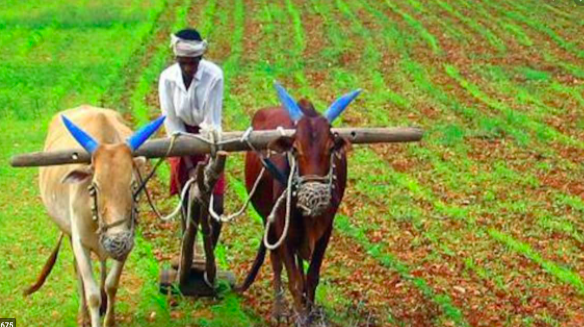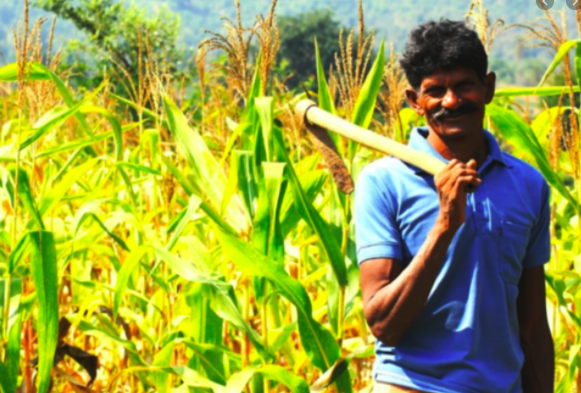Commercial farming is basically growing crops to sell produce for profit in the local or export market. In the old days, most farmers in India used to cultivate crops for their own food purpose which is individual agriculture.
In other words, commercial farming is farming done for a profit, where food is produced for sale in the market by advanced technological means. Often very few workers are employed.

Types of Commercial Farming:
Intensive commercial farming: It is a system of agriculture in which a relatively large amount of capital or labor is applied to relatively small areas of land. This is commonly practiced where population pressure is reducing the size of the landholding. West Bengal practices intensive commercial farming.
Extensive commercial farming: It is a system of agriculture in which a relatively small amount of capital or labor investment is applied to relatively large areas of land. Many times, the land is released to regain its fertility. It is mostly mechanized due to the cost and availability of labor. It usually occurs on the margins of the agricultural system, from the market, or on poor land of limited capacity and is commonly practiced in the Terai regions of southern Nepal. The crops grown are sugarcane, rice, and wheat.
Plantation agriculture: Plantation is a large farm or property that usually occurs in a tropical or subtropical country where crops are grown for sale in distant markets rather than local consumption.
Commercial Cereal Farming: This type of farming is a response to farm mechanization and is the predominant type of activity in low rainfall and low-density areas of the population where extensive farming is practiced. Crops are spoiled by weather and wheat genocide is common practice.
Difference between commercial farming and subsistence farming:
Subsistence agriculture is commonly found in less developed countries, and food is produced for the immediate family of the farmer. Farmers cultivate farming for survival, and usually do not make a profit from the crops they grow. Commercial agriculture is commonly found in more developed countries, and crops are grown in large quantities to support the entire population for a profit.
The main things that distinguish commercial agriculture from subsistence agriculture are the objectives, the number of farmers in the workforce, the use of machinery, the size of the farm, and the relationship with other occupations.
1. The purpose of farming in LDCs varies from subsistence farmers and commercial farmers to MDCs. Farmers cultivate farmers for survival. The crops they grow are for their immediate family consumption. Often, the crop they grow is their only source of food. Any surplus that sustains farmers can be sold to governments or traded among other villagers. Commercial farmers grow crops and raise large amounts of livestock for profit rather than for their own consumption.
Commercial products are produced in bulk to support the entire population. The products they produce are not sold directly to consumers but are sent to food processing companies. From here, products are sent to markets and stores to be sold to consumers.
2. The percentage of farmers in the workforce in MDC is less than 5%. In some countries, such as the United States and Canada, only 2 percent of the workforce is farmers. In LDCs, about 55% of the workforce consists of subsistence farmers.

3. In MDCs, the number of farmers has declined dramatically as machinery use has increased. In MDCs, a lot of farmers are able to feed so many people due to the use of technology used for farming. In LDCs, farmers have to depend on man and animal power to produce crops. Commercial farmers also use scientific advances to increase their production. Scientists have been able to produce new fertilizers, herbicides, hybrid plants, animal breeds, and cultivation methods, which have contributed to the ability of commercial farmers to deliver high yields.
4. Another difference between commercial and subsistence agriculture is farm size. At MDC, commercial farms are relatively large, particularly in the US and Canada. Most commercial farms are family-owned and operated. As the size of farms in MDCs is increasing, the volume of large farms is decreasing as the need for more farms is decreasing. However, the land dedicated to farming grew mainly through irrigation and reclamation.
Characteristics of commercial farming:
Crops and livestock are extensively produced in commercial farming and are grown on large farms using machinery, irrigation methods, chemical fertilizers, and other technologies.
The basic point of mass production of such products is to export them to other regions or countries where their demand is high.
For example, most Gulf nations depend on food imports because the climate in such countries cannot support agriculture. In other countries, large-scale imports are used as raw materials in industries. Following are the exact features in detail.

1. Mass Production
Commercial farming produces livestock and crops in large numbers. For this reason, a lot of land, advanced technology, and expertise are required to meet the expected production goals or targets.
2. It is capital intensive
Since it requires a lot of investment before the practice starts, it means a lot of capital is needed to get it up and running.
Capital is used to purchase agricultural materials such as seedlings or seeds, fertilizers and pesticides, machinery, farmland, and to pay for expenses such as water and electricity bills, and labor and expertise.
3. Use of high yielding varieties (HYV)
The practice of commercial farming uses high doses of modern inputs and high-yielding varieties of seeds, chemical fertilizers, pesticides, weed pesticides, and pesticides. This is done to achieve high production but has a detrimental effect on environmental sustainability.
4. It is produced for sale
Unlike other forms of agriculture where people cultivate for their own use, commercial farming is done for sale only.
Under commercial agriculture, thousands of acres of products such as millet, cocoa, bananas, rice, sugarcane, tea, and other products are harvested and sold, mainly as exports to other countries.
5. Heavy machinery and human labor
Commercial farming requires a large supply of both skilled and unskilled labor. While skilled labor in commercial labor comes from professionals, unskilled labor exploits immigrants and individuals living in absolute poverty.
Heavy machinery such as excavators, sprayers, trousers, harvesters, and planters are also needed to accomplish goals and targets in time, as well as to mention some machines to hone the skills of the system of production.
6. In most cases, a type of agricultural practice is practiced over a large area.
Commercial farming can involve different farming practices of the same land or area, mainly including one type of farming method such as aquaponics, beef farming, dairy farming, poultry, coffee farming, sugarcane farming. Special fruitful plantations, floriculture, and tea cultivation in a field or large piece of land, among many others.
7. This practice is traditionally carried out throughout the year
Commercial agriculture is unique because farmers can irrigate land or keep agricultural systems operational throughout the year.
They do not rely on rain or natural supplies as normal farmers do because they have advanced technology, machines, and artificial growth enhancers to keep their crops or animals full-time.
Commercial farming benefits:
1. Encouraging improvement in local infrastructure
Commercial farming helps a region or country to establish or improve the infrastructure of the region like roads and electricity.
For example, commercial farms depend on electricity, and to run the fields with electricity, surrounding communities will also be wired. Furthermore, when roads improve, they help both the farms and the people living nearby.
Also, water is transported to surrounding communities.

2. Job creation
Commercial farming is a source of jobs for individuals living within the area. Workers will earn some money, which will enable them to provide food for their families. As such, commercial farming encourages the development of the local economy.
3. Lowering the price of products
Commercial farming helps in reducing the cost of agricultural products as a sufficient number of crops are available in the market. Therefore, the forces of demand and supply services reduce the prices of such goods.
4. Increasing production and enhancing food security
Commercial farming operates instruments, controlling diseases and pests, leading to greater production in the fields. As a result, commercial farmers increase production, helping to increase the national stock of food products.
5. Provision of raw materials for agribusiness manufacturing companies
Commercial agriculture takes advantage of more raw materials to feed local and international industries that engage in the production or manufacture of agricultural by-products.
For example, the manufacture of juices is enabled in commercial quantities by cultivating fruits such as pineapples, mangoes, and oranges. Coffee and cocoa cultivation also work in the confectionery industries.
6. Reducing the cost of production
As farmers adopt more efficient methods of production, such as the use of harvesters, plows, harrows, and orchards, commercial farmer operations become cheaper in the long run.
7. Forex earner
Commercial farming helps countries in the world earn higher foreign exchange. For example, in West Africa, the export of cocoa and coffee has earned an attractive foreign exchange to the countries concerned, promoting economic growth.
Drawbacks of commercial farming:
1. Inadequate supply of advanced varieties of crops and animals: This is simply to say, there is an insufficient supply of advanced varieties of crops and some breeds of animals.
2. Adverse land tenure system: Adverse land tenure system does not allow the practice of commercial agriculture in some parts of the world.
3. High capital investment: The high cost of most agricultural machinery makes commercial agriculture very difficult to engage.
4. Inadequate marketing channels: Agricultural products marketing channels are inadequate in most developing countries.
5. Insufficient technical information: Inadequate technical information makes commercial agriculture very difficult on proper maintenance and use of agricultural machinery.
6. High cost of spare parts: It is very expensive to buy spare parts of agricultural implements like tractors, harvesters, etc.
7. Inadequate processing facilities: Processing facilities for agricultural products from farms are grossly inadequate.
8. Insufficient Skilled Manpower: The skilled manpower required to operate commercial agriculture is also not in short supply or sufficiently adequate.
9. Inadequate credit facilities: As a result of inadequate credit facilities or subsidies available to farmers, commercial agriculture cannot do very well.
10. Inadequate storage and processing facilities: Processing facilities are inadequate in most developing countries of the world.
Check out our other blog on Commercial Farming HERE!


